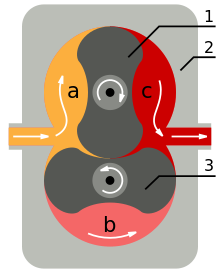
Connersville is a city in Fayette County, east central Indiana, United States, 66 miles (106 km) east by southeast of Indianapolis. The population was 13,324 at the 2020 census. The city is the county seat of and the largest and only incorporated town in Fayette County. The city is in the center of a large rural area of east central Indiana; the nearest significant city is Richmond, 26 miles (42 km) to the northeast by road. Connersville is home to the county's only high school. The local economy relies on manufacturing, retail, and healthcare to sustain itself. However, there has been a consistent decline in both employment and population since the 1960s, placing it among the least affluent areas in the state, as indicated by measures such as median household income and other economic indicators.

The Roots blower is a positive displacement lobe pump which operates by pumping a fluid with a pair of meshing lobes resembling a set of stretched gears. Fluid is trapped in pockets surrounding the lobes and carried from the intake side to the exhaust.
A centrifugal supercharger is a specialized type of supercharger that makes use of centrifugal force in order to increase the manifold air pressure, MAP. An increased MAP allows the engine to burn more fuel, which results in an increased power output. Centrifugal superchargers are generally attached to the front of the engine via a belt-drive or gear-drive from the engine's crankshaft.
Dresser Industries was a multinational corporation headquartered in Dallas, Texas, United States, which provided a wide range of technology, products, and services used for developing energy and natural resources. In 1998, Dresser merged with its main rival Halliburton. Halliburton sold many of former Dresser non "oil patch" divisions, retaining the M W Kellogg Engineering and Construction Company and the Dresser oil-patch products and services that complemented Halliburton's energy and natural resource businesses. In 2001 Halliburton sold five separate, but somewhat related former Dresser non "oil patch" divisions, to an investment banking firm. Those five operations later took the name "Dresser Inc." In October 2010, Dresser Inc., was acquired by General Electric. It is headquartered in Addison, Texas.

A compressor is a mechanical device that increases the pressure of a gas by reducing its volume. An air compressor is a specific type of gas compressor.
Henry Neil Mallon was an American businessman. He served as the chair of the board, president, and director of Dresser Industries.

The Rolls-Royce RB.23 Welland was Britain's first production jet engine. It entered production in 1943 for the Gloster Meteor. The name Welland is taken from the River Welland, in keeping with the Rolls-Royce policy of naming early jet engines after rivers based on the idea of continuous flow, air through the engine and water in a river.
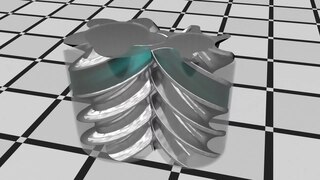
A rotary-screw compressor is a type of gas compressor, such as an air compressor, that uses a rotary-type positive-displacement mechanism. These compressors are common in industrial applications and replace more traditional piston compressors where larger volumes of compressed gas are needed, e.g. for large refrigeration cycles such as chillers, or for compressed air systems to operate air-driven tools such as jackhammers and impact wrenches. For smaller rotor sizes the inherent leakage in the rotors becomes much more significant, leading to this type of mechanism being less suitable for smaller compressors than piston compressors.

In an internal combustion engine, a supercharger compresses the intake gas, forcing more air into the engine in order to produce more power for a given displacement.

A centrifugal fan is a mechanical device for moving air or other gases in a direction at an angle to the incoming fluid. Centrifugal fans often contain a ducted housing to direct outgoing air in a specific direction or across a heat sink; such a fan is also called a blower, blower fan, or squirrel-cage fan. Tiny ones used in computers are sometimes called biscuit blowers. These fans move air from the rotating inlet of the fan to an outlet. They are typically used in ducted applications to either draw air through ductwork/heat exchanger, or push air through similar impellers. Compared to standard axial fans, they can provide similar air movement from a smaller fan package, and overcome higher resistance in air streams.
Ingersoll Rand Inc. is an American multinational company that provides flow creation and industrial products. The company was formed in February 2020 through the spinoff of the industrial segment of Ingersoll-Rand plc and its merger with Gardner Denver. Its products are sold under more than 40 brands across all major global markets.
An electric supercharger is a specific type of supercharger for internal combustion engines that uses an electrically powered forced-air system that contains an electric motor to pressurize the intake air. By pressurizing the air available to the engine intake system, the air becomes more dense, and is matched with more fuel, producing the increased horsepower to the wheels.
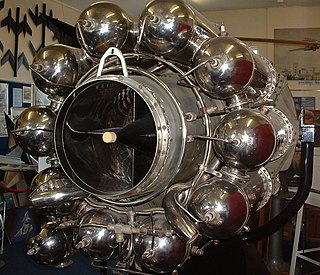
The Power Jets W.2 was a British turbojet engine designed by Frank Whittle and Power Jets Ltd. Like the earlier Power Jets W.1, the reverse-flow combustion configuration included a double-sided centrifugal compressor, 10 combustion chambers and an axial-flow turbine with air-cooled disc. It entered production as the Rolls-Royce Welland and was the first UK jet engine to power operational aircraft, the Gloster Meteor.
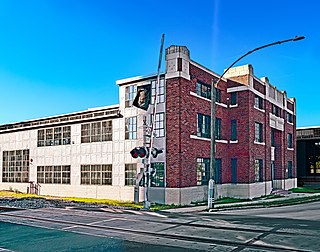
Cameron International Corporation (formerly Cooper Cameron Corporation (CCC) and Cooper Oil Tool, Cameron Iron Works) though now operating under Schlumberger, is a global provider of pressure control, production, processing, and flow control systems as well as project management and aftermarket services for the oil and gas and process industries. Cameron was acquired by Schlumberger (SLB) in 2016, and now operates as 'Cameron, an SLB Company.' At the start of the SLB acquisition in 2015, Cameron employed approximately 23,000 people and delivered $9.8 billion in revenue.
Dresser-Rand is an American engineering and manufacturing company owned by Siemens Energy. The company designs, manufactures, and services equipment used in the extraction of petroleum and natural gas. The company was formed in 1986 as a joint venture of Dresser Industries and Ingersoll Rand.
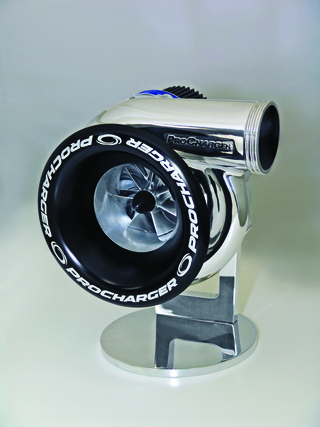
ProCharger is the automotive supercharger division of Accessible Technologies, Inc. (ATI), a manufacturer of centrifugal compressor technology in multiple industries, located in the Kansas City metropolitan area. Inovair is the name of the company’s industrial products division.
Howden Turbo GmbH is a German engineering company, based in Frankenthal in the state of Rhineland-Palatinate. The company was formed after Colfax Corporation acquired Siemens Turbomachinery Equipment GmbH (STE) from Siemens in October 2017 for €195 million. The old brand name Kühnle, Kopp & Kausch has been returned to use. The Kühnle, Kopp & Kausch AG was a German mechanical engineering company based in Frankenthal. The company was acquired by Siemens and bore the name Siemens Turbomachinery Equipment GmbH (STE) until 2017. The company was renamed Howden Turbo GmbH through the sale to Colfax Corporation and Howden.
The Marshall supercharger was a Roots-type supercharger based on a patent by John Wilmot Marshall in 1933
The Wade supercharger was a Roots-type supercharger designed for internal combustion engines and produced from 1947 by the newly formed Wade Engineering Ltd, of Gatwick Airport, Horley, Surrey. The name 'WADE' comes from Winslett And DEnsham, after Bryan Winslett and Costin Densham.
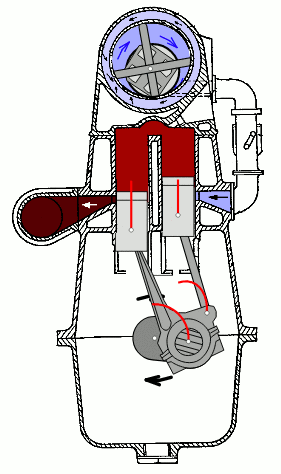
The Zoller supercharger was a vane-type supercharger created by Arnold Zoller (1882-1934) who had patents regarding supercharging engines before WW1. The Zoller supercharger was popular in the 1920s and 1930s.


